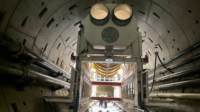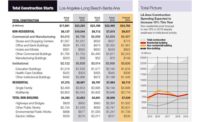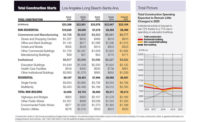Work is underway on the final and most important phase of a project in eastern Los Angeles County that aims to relieve congestion in the worst truck bottleneck in California. Officials broke ground earlier this month on Phase III of the State Route 57/60 Confluence project in the cities of Diamond Bar and the City of Industry.
The project was originally slated to launch in 2025 but the LA Metro board of directors voted in January to accelerate funding of the $441 million project. The San Gabriel Valley Council of Governments (SGVCOG) awarded Skanska a $267-million contract in April to make the mainline freeway improvements, with completion scheduled for July 2028.
"Upon completion, this transformative project will substantially reduce traffic congestion and improve freight movement daily," Rep. Judy Chu (D-Calif.) said at the groundbreaking ceremony.
SR 57, also known as the Orange Freeway, is one of the few north-south freeways in Southern California. It serves as a key link between Orange County and eastern Los Angeles County. SR 60, the Pomona Freeway, connects Los Angeles County and the most populous parts of the Inland Empire, serving as the preferred route for truck traffic.
An average of 350,000 vehicles per day passes through the two-mile-long confluence of the two freeways including an inordinate amount of truck traffic. In 2020, it was ranked the worst truck bottleneck in California and the ninth worst in the nation, as well as the second-highest truck accident location in Southern California. Truck-related accidents occur 50% more frequently at the interchange than the state average.
The problems with the interchange stem from its unusual design—it is the only Southern California freeway interchange not built at 90° angles. As a result, 17 lanes compress into 14, with traffic often grinding to a halt and drivers weaving between lanes.
“The existing lane configuration of the shared alignment of both the SR 57/60 creates a chokepoint that results in severe congestion and numerous accidents,” according to SGVCOG.
To address these issues, project engineers have come up with four solutions:
- A mile-long eastbound 60 off-ramp bypass lane that is meant to eliminate weaving in and out of traffic to exit the 60 to Grand Avenue.
- An eight-lane overpass bridge with a loop on-ramp that will connect southbound Grand Avenue to the eastbound 60.
- A half-mile-long elevated bypass over Diamond Bar Boulevard to be used as a bypass for eastbound 60 commuters.
- A widening of the on-ramp from Diamond Bar Boulevard to the eastbound 60 from two to three lanes.
In the earlier phases of the project, crews built a westbound 60 on-ramp at Grand Avenue, made street widening improvements in the vicinity of Grand Avenue and Golden Springs Drive, and constructed a westbound 60 off-ramp and auxiliary lane to Grand Avenue.
Bidding for Phase III began in December 2022 with five firms submitting bids. Skanska's bid of $266.9 million was 6% lower that SGVCOG's in-house estimate and just $5.6 million more than OHLA USA's. OHLA subsequently contested the award on the grounds Skanska' included an improperly qualified DBE subcontractor. SVGCOG staff rejected OHLA’s protest.





Post a comment to this article
Report Abusive Comment